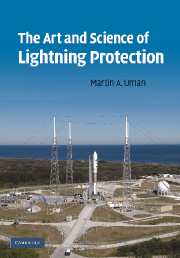Book contents
- Frontmatter
- Contents
- Preface
- 1 What is lightning?
- 2 Lightning damage
- 3 General methods for lightning protection: Faraday cages, topological shields; and more practical approaches: cone of protection and rolling sphere methods
- 4 Structure protection: air terminals and down conductors
- 5 Structure protection: grounding
- 6 Surge protection for electronics in low-voltage electrical systems
- 7 Humans and animals
- 8 Lightning warning
- 9 Airships, airplanes, and launch vehicles
- 10 Ships and boats
- 11 Trees
- 12 Overhead and underground power and communication lines
- 13 Lightning elimination
- 14 So, what do we know and what don't we know about lightning protection?
- Index
Preface
Published online by Cambridge University Press: 17 November 2009
- Frontmatter
- Contents
- Preface
- 1 What is lightning?
- 2 Lightning damage
- 3 General methods for lightning protection: Faraday cages, topological shields; and more practical approaches: cone of protection and rolling sphere methods
- 4 Structure protection: air terminals and down conductors
- 5 Structure protection: grounding
- 6 Surge protection for electronics in low-voltage electrical systems
- 7 Humans and animals
- 8 Lightning warning
- 9 Airships, airplanes, and launch vehicles
- 10 Ships and boats
- 11 Trees
- 12 Overhead and underground power and communication lines
- 13 Lightning elimination
- 14 So, what do we know and what don't we know about lightning protection?
- Index
Summary
One of the questions I've most been asked is “Do lightning rods really work?” The question can be phrased more accurately as “Does the standard lightning protection eliminate the possibility of lightning damage to structures?”; and the answer is “almost always.” Nevertheless, there are many individuals who erroneously believe that installing lightning protection on a structure significantly increases the risk of that structure's being struck and hence damaged by lightning, a relatively common view during the nineteenth century when little was known about the physics of lightning. Among those individuals who still so believe, as brought to my attention recently by an investigative newspaper reporter, are important officials in at least several high-profile fire departments, individuals who should know better. There are both international and national standards for installing lightning protection systems, and in this book I examine the assumptions underlying the common approach taken in all the standards and the resultant adequacy of those standards.
I am also often asked about the efficacy of the two commercially available methods of “non-standard” lightning protection, non-standard in that they are not recommended in either the primary international standard or the US standard. Each method involves the use of unusual lightning rods (air terminals), in one case purportedly to attract the lightning from relatively far away so that fewer air terminals are needed and in the other case purportedly either to discharge the thundercloud (the latter possibility being originally proposed by Benjamin Franklin based on his laboratory experiments) or, at minimum, to emit enough electrical charge into the atmosphere surrounding the air terminal to repel lightning from the local vicinity.
- Type
- Chapter
- Information
- The Art and Science of Lightning Protection , pp. xi - xivPublisher: Cambridge University PressPrint publication year: 2008



